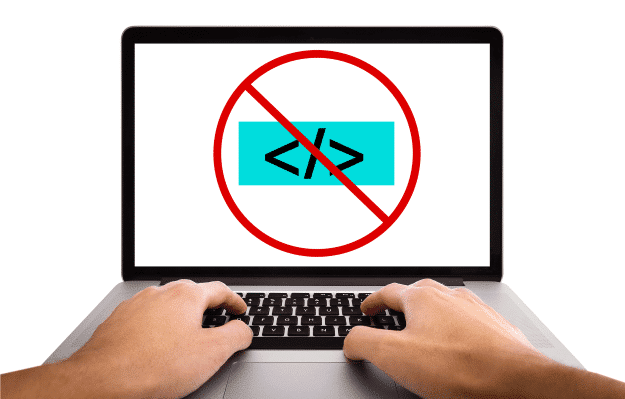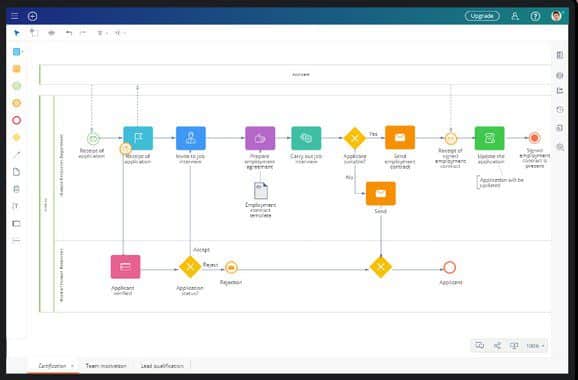
Responding to the promise of creating applications or websites with little or no code, low-code and no-code solutions are becoming increasingly popular. They help to combat the shortage of developers, speed up project release and leave it to business experts to create applications and websites that meet their needs. But does this mean the end of developers?
La digital transformation is increasing the pressure on the IT department. Overworked and suffering from a shortage of developers, the IT department is struggling to meet the needs of the business departments (finance, HR, purchasing, sales, marketing, etc.). However, the digitalisation of our economy means that we need to shorten the time-to-market for innovative solutions, whether they be applications (mobile or web), websites, software, APIs or process automation systems.
For want of anything better, the business units are multiplying the number of applications under the IT Department's radar. A " shadow IT "which exposes the company to risks of cyber security and non-compliance with the rest of the information system (IS).
The low code/no code solution
The low code/no code movement is one response to these needs. As the name suggests, the aim is to create applications with as little code as possible (low code) or even without a single line of code (no code). Using a visual 100 % interface, they manipulate application components that they drag and drop to create the architecture of the future solution and trigger actions when predefined events occur.
On paper, it's a win-win situation. Developers increase their productivity by reusing a set of resources and model libraries. This optimisation of code is part of the natural evolution of software engineering workshops and rapid application development (RAD) tools.

No code puts business experts back in control
For their part, business experts, renamed "citizen developers", create their own applications completely independently and without any programming knowledge. The only prerequisites are a sense of logic and an advanced command of office automation tools, particularly Microsoft Excel.
In a WYSIWYG (What You See Is What You Get) logic, the user visualises the rendering of the future application and can carry out tests before arriving at the final version. For the moment, this approach is used for simple, clearly identified use cases, such as a meeting room reservation application or a form for drawing up a land inventory. It also makes it possible to design a prototype that the in-house IT specialists will enhance functionally and then integrate into the IS.
A trend accentuated by the pandemic
According to GartnerThe health crisis has only reinforced this trend, with the need to automate workflows. The global market for low-code development technologies alone is expected to grow by 23 % in 2021 to reach $5.8 billion. And the best is yet to come, according to the consultancy firm, which plans that 80 % of technological products and services could be designed by non-computer scientists by 2024.
Beyond the pandemic, the market is also benefiting from the porting of low-code application platform (LCAP) solutions to the cloud, which is helping to democratise the market. Finally, with such growth, it is attracting the covetousness of a large number of players. Alongside the pure players in low code (OutSystems and Mendix, acquired by Siemens) and no code (Weebly, Caspio, Bubble, Zapier), there are new entrants from a wide variety of backgrounds.
Established players in business process management (BPM) and case management, such as Appian, Pega and Bonitasoft, have naturally positioned themselves in this niche. As specialists in the automation of business processes and the management of business rules, they have every right to make this shift to low code.
This segment also includes ServiceNow, which is well known to CIOs as a specialist in IT service management (ITSM). With the acquisition of SkyGiraffe in 2017, the American publisher is now able to offer a low-code development studio dedicated to mobile applications. Another family: specialists in the robotisation of business processes or RPA (Robotic process automation) such as UiPath, Automation Anywhere or Blue Prism. Once again, this is a natural evolution. Complementary to RPA, a low/no code environment can be used to manage workflows that are not eligible for processing by bots by creating intelligent workflows.
Making way for hyper-automation of processes
By combining RPA, low/no code and artificial intelligence, we can even talk about platforms known as hyperautomation, one of the technology trends for 2022 identified by Gartner. Another, more discreet, wave is that of so-called "intelligent" spreadsheets which include a dose of low/code to create customised dashboards and automated workflows. Following in the footsteps of the pioneer and leader, Airtable, Smartsheet and JotForm's Tables have all entered this niche.
Lastly, the GAFAMs could not remain on the sidelines of this fundamental movement. With Power Apps, Microsoft capitalises on its ecosystem. Users will find the familiar 'look' of Microsoft 365 and benefit from the synergies with the other building blocks of its collaborative suite, in particular Power BI, its data visualisation solution. Another module from the Redmond firm, Power Virtual Agents enables users to create chatbots.
Amazon Web Services' (AWS) Honeycode is taking the same gamble. The hyperscaler is using its portfolio of cloud solutions to enhance its low-code development platform. Amazon AppFlow makes it possible to manage data flows between in-house services such as Amazon S3 and Amazon Redshift and third-party applications such as SAP, Zendesk, Slack or ServiceNow, without the need for code.
Other digital giants include Google and SAP, which have respectively acquired AppSheet and AppGyver, two no-code platforms. Salesforce paved the way for the market by launching Lightning, an application development framework, back in 2015. Since then, the company has developed various code optimisation solutions. The latest, Dynamic Interactions, is aimed at non-developers. Salesforce is ranked as a leader in Gartner's latest Magic Quadrant, alongside Mendix, Microsoft, OutSystems and ServiceNow.
The end of developers?
Will the proliferation of these tools spell the end of code and, by extension, the end of developers? Chris Wanstrath, the founder of GitHub, the famous software hosting and development service, predicted back in 2017: "The future of code is no code at all".
However, while no code is aimed at non-computer specialists and low code at developers who want to create projects quickly, these tools do have their limits. These solutions democratise digital production by making it possible to set up simple projects. Beyond that, developers will always have their place in more complex projects. Coders and non-coders will therefore continue to coexist.


